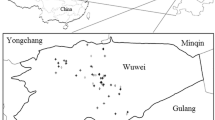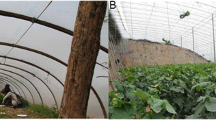Abstract
The present study aimed to assess the potential ecological risk of heavy metals and nutrient accumulation in polytunnel greenhouse soils in the Yellow River irrigation region (YRIR), Northwest China, and to identify the potential sources of these heavy metals using principal component analysis. Contents of available nitrogen (AN), phosphorus (AP), and potassium (AK) in the surface polytunnel greenhouse soils (0–20 cm) varied from 13.42 to 486.78, from 39.10 to 566.97, and from 21.64 to 1,156.40 mg kg−1, respectively, as well as AP, soil organic matter (SOM) and AK contents tended to increase significantly at the 0–20- and 20–40-cm soil layers. Heavy metal accumulations occurred in the polytunnel greenhouse soils as compared to arable soils, especially at a depth of 20 cm where Cd, Zn and Cu contents were significantly higher than arable soil. Cd and As were found to be the two main polluting elements in the greenhouse soils because their contents exceeded the thresholds established for greenhouse vegetable production HJ333-2006 in China and the background of Gansu province. It has been shown that Cd, Cu, Pb and Zn at the 0–20-cm soil layer were derived mainly from agricultural production activities, whereas contents of Cr and Ni at the same soil layer were determined by ‘natural’ factors and As originated from natural sources, deposition and irrigation water.


Similar content being viewed by others
References
Ana de, S. M., Inmaculada V. A., Jose R. Q., Antonio, V., Antonio L. L., & Concepción G. H. (2014). Carbonate, organic and clay fractions determine metal bioavailability in periurban calcareous agricultural soils in the Mediterranean area.Geoderma, 221–222, 103–112.
Bot, G. (2001). The solar greenhouse; technology for low engergy consumption, International Congress on Greenhouse Vegetables. The Production Chain of Fresh Tomatoes, Peppers and Cucumbers, 611, 61–71.
Cantliffe, D. J., Shaw, N., Jovicich, E., Rodriguez, J. C., Secker, I., & Karchi, Z. (2001). Passive ventilated high-roof greenhouse production of vegetables in a humid, mild winter climate. Acta Horticulturae, 1, 195–202.
Chen, T., Liu, X. M., Li, X., Zhao, K. L., Zhang, J. B., Xu, J. M., Shi, J. C., & Dahlgren, R. A. (2009). Heavy metal sources identification and sampling uncertainty analysis in a field-scale vegetable soil of Hangzhou, China. Environmental Pollution, 157(3), 1003–1010.
Chen, Y., Huang, B., Hu, W. Y., Weindorf, D. C., & Yang, L. Q. (2013). Environmental assessment of closed greenhouse vegetable production system in Nanjing, China. Journal of Soils and Sediments, 13, 1418–1429.
Chiu, K. K., Ye, Z. H., & Wong, M. H. (2006). Growth of Vetiveria zizanioides and Phragmites australis on Pb/Zn and Cu mine tailings amended with manure compost and sewage sludge: a greenhouse study. Bioresource Technology, 97, 158–170.
Darilek, J. L., Huang, B., Wang, Z., Qi, Y., Zhao, Y., Sun, W., Gu, Z., & Shi, X. (2009). Changes in soil fertility parameters and the environmental effects in a rapidly developing region of China. Agriculture, Ecosystems & Environment, 129(1), 286–292.
Darwish, T., Atallah, T., El Moujabber, M., & Khatib, N. (2005). Salinity evolution and crop response to secondary soil salinity in two agro-climatic zones in Lebanon. Agricultural Water Management, 78(1), 152–164.
Dragović, S., Mihailović, N., & Gajić, B. (2008). Heavy metals in soils: distribution, relationship with soil characteristics and radionuclides and multivariate assessment of contamination sources. Chemosphere, 72(3), 491–495.
Fernández, M. D., Cagigal, E., Vega, M. M., Urzelai, A., Babín, M., Pro, J., & Tarazona, J. V. (2005). Ecological risk assessment of contaminated soils through direct toxicity assessment. Ecotoxicology and Environmental Safety, 62, 174–184.
Facchinelli, A., Sacchi, E., & Mallen, L. (2001). Multivariate statistical and GIS-based approach to identify heavy metal sources in soils. Environmental Pollution, 114(3), 313–324.
FAO, (2005). http://faostat.fao.org.
Gil, C., Boluda, R., & Ramos, J. (2004). Determination and evaluation of cadmium, lead and nickel in greenhouse soils of Almer ıa (Spain). Chemosphere, 55, 1027–1034.
Gou, X., Li, Y., & Wang, G. (2007). Heavy metal concentrations and correlations in rain-fed farm soils of Sifangwu village, central Gansu Province, China. Land Degradation & Development, 18(1), 77–88.
Gruda, N. (2005). Impact of environmental factors on product quality of greenhouse vegetables for fresh consumption. Critical Reviews in Plant Sciences, 24(3), 227–247.
Gupta, S., Satpati, S., Nayek, S., & Garai, D. (2010). Effect of wastewater irrigation on vegetables in relation to bioaccumulation of heavy metals and biochemical changes. Environmental Monitoring and Assessment, 165(1–4), 169–177.
Hakanson, L. (1980). An ecological risk index for aquatic pollution control. A sedimentological approach. Water Research, 14(8), 975–1001.
Hernandez, L., Probst, A., Probst, J. L., & Ulrich, E. (2003). Heavy metal distribution in some French forest soils: evidence for atmospheric contamination. Science of the Total Environment, 312(1), 195–219.
Hu, Y. C., Song, Z. W., Lu, W. L., Poschenrieder, C., & Schmidhalter, U. (2012). Current soil nutrient status of intensively managed greenhouses. Pedosphere, 22(6), 825–833.
Huang, B., Shi, X. Z., Yu, D. S., Öborn, I., Blombäck, K., Pagella, T. F.,Wang, H. J., Sun, W. X., & Sinclair, F. L. (2006). Environmental assessment of small-scale vegetable farming systems in peri-urban areas of the Yangtze River Delta Region, China. Agriculture, Ecosystems & Environment, 112(4), 391–402.
Jan, F. A., Ishaq, M., Khan, S., Ihsanullah, I., Ahmad, I., & Shakirullah, M. (2010). A comparative study of human health risks via consumption of food crops grown on wastewater irrigated soil (Peshawar) and relatively clean water irrigated soil (lower Dir). Journal of Hazardous Materials, 179(1), 612–621.
Kalis, E. J. J., Temminghoff, E. J. M., Weng, L., & van Riemsdijk, W. H. (2006). Effects of humic acid and competing cations onmetal uptake by Lolium perenne. Environmental Toxicology and Chemistry, 25(3), 702–711.
Kara, E. E., Pirlak, U., & Özdılek, H. G. (2004). Evaluation of heavy metals’ (Cd, Cu, Ni, Ph, and Zn) distribution in sowing regions of potato fields in the Province of Niğde, Turkey. Water, Air, and Soil Pollution, 153(1–4), 173–186.
Khan, S., Cao, Q., Zheng, Y. M., Huang, Y. Z., & Zhu, Y. G. (2008). Health risks of heavy metals in contaminated soils and food crops irrigated with wastewater in Beijing, China. Environmental Pollution, 152(3), 686–692.
Liao, X. Y., Chen, T. B., Xie, H., & Liu, Y. R. (2005). Soil As contamination and its risk assessment in areas near the industrial districts of Chenzhou City, Southern China. Environment International, 31(6), 791–798.
Liu, P., Zhao, H. J., Wang, L. L., Liu, Z. H., Wei, J. L., Wang, Y. Q., Jiang, L. H., Dong, L., & Zhang, Y. F. (2011). Analysis of heavy metal sources for vegetable soils from Shandong Province, China. Agricultural Sciences in China, 10(1), 109–119.
Lu, R. K. (1999). Agro-chemical analysis methods of soil. Beijing: Chinese Agriculture Scientific Press (in Chinese).
Manta, D. S., Angelone, M., Bellanca, A., Neri, R., & Sprovieri, M. (2002). Heavy metals in urban soils: a case study from the city of Palermo (Sicily), Italy. Science of the Total Environment, 300(1), 229–243.
Masscheleyn, P. H., Delaune, R. D., & Patrick, W. H., Jr. (1991). Effect of redox potential and pH on arsenic speciation and solubility in a contaminated soil. Environmental Science & Technology, 25(8), 1414–1419.
Meng, Q. F., Yang, J. S., Yao, R. J., & Liu, G. M. (2013). Soil quality in east coastal region of China as related to different land use types. Journal of Soils and Sediments, 1–13.
Murugan, A. V., Swarnam, T. P., & Gnanasambandan, S. (2013). Status and effect of pesticide residues in soils under different land uses of Andaman Islands, India. Environmental monitoring and assessment, 1–11.
Nabulo, G., Black, C. R., & Young, S. D. (2011). Trace metal uptake by tropical vegetables grown on soil amended with urban sewage sludge. Environmental Pollution, 159(2), 368–376.
Niu, L. L., Yang, F. X., Xu, C., Yang, H. Y., & Liu, W. P. (2013). Status of metal accumulation in farmland soils across China: from distribution to risk assessment. Environmental Pollution, 176, 55–62.
Qian, Y., Gallaghe, F. J., Feng, H., & Wu, M. (2012). A geochemical study of toxic metal translocation in an urban brownfield wetland. Environmental Pollution, 166, 23–30.
Recatalá, L., Sacristán, D., Arbelo, C., & Sánchez, J. (2011). Can a single and unique cu soil quality standard be valid for different Mediterranean agricultural soils under an accumulator crop? Water, Air, and Soil Pollution, 223(4), 1503–1517.
Rodríguez Martín, J. A., Ramos-Miras, J. J., Boluda, R., & Gil, C. (2013). Spatial relations of heavy metals in arable and greenhouse soils of a Mediterranean environment region (Spain). Geoderma, 200, 180–188.
Smith, E., Naidu, R., & Alston, A. M. (1998). Arsenic in the soil environment: a review. Advances in Agronomy, 64, 149–195.
Sun, C. Y., Liu, J. S., Wang, Y., Sun, L. Q., & Yu, H. W. (2013). Multivariate and geostatistical analyses of the spatial distribution and sources of heavy metals in agricultural soil in Dehui, Northeast China. Chemosphere, 92(5), 517–523.
Wang, Y. M., Chen, P., Cui, R. N., Si, W. T., Zhang, Y. M., & Ji, W. H. (2010a). Heavy metal concentrations in water, sediment, and tissues of two fish species (Triplohysa pappenheimi, Gobio hwanghensis) from the Lanzhou section of the Yellow River, China. Environmental Monitoring and Assessment, 165(1–4), 97–102.
Wang, X. D., Chen, X. N., Liu, S., & Ge, X. Z. (2010b). Effect of molecular weight of dissolved organic matter on toxicity and bioavailability of copper to lettuce. Journal of Environmental Sciences, 22(12), 1960–1965.
Wu, S., Xia, X. H., Lin, C. Y., Chen, X., & Zhou, C. H. (2010). Levels of arsenic and heavy metals in the rural soils of Beijing and their changes over the last two decades (1985–2008). Journal of Hazardous Materials, 179(1), 860–868.
Yang, S. L., Zhou, D. Q., Yu, H. Y., Wei, R., & Pan, B. (2013). Distribution and speciation of metals (Cu, Zn, Cd, and Pb) in agricultural and non-agricultural soils near a stream upriver from the Pearl River, China. Environmental Pollution, 177, 64–70.
Yu, J., Huang, Z. Y., Chen, T., Qin, D. P., Zeng, X. C., & Huang, Y. F. (2012). Evaluation of ecological risk and source of heavy metals in vegetable-growing soils in Fujian province, China. Environmental Earth Sciences, 65(1), 29–37.
Zeng, F. R., Ali, S., Zhang, H. T., Ouyang,Y. N., Qiu, B. Y., Wu, F. B., & Zhang, G. P. (2011). The influence of pH and organic matter content in paddy soil on heavy metal availability and their uptake by rice plants. Environmental Pollution, 159(1), 84–91.
Zhang, H. Z., Li, H., Wang, Z., & Zhou, L. D. (2011). Accumulation characteristics of copper and cadmium in greenhouse vegetable soils in Tongzhou District of Beijing. Procedia Environmental Sciences, 10, 289–294.
Zhou, J., Ma, D. S., Pan, J. Y., Nie, W. M., & Wu, K. (2008). Application of multivariate statistical approach to identify heavy metal sources in sediment and waters: a case study in Yangzhong, China. Environmental Geology, 54(2), 373–380.
Acknowledgments
This study was funded by the National Natural Science Foundation of China (Grant No. 31071866) and the Scientific Research Project of the Department of Agriculture and animal husbandry of Gansu province (Grant No. 2012-47).
Author information
Authors and Affiliations
Corresponding author
Rights and permissions
About this article
Cite this article
Kong, X., Cao, J., Tang, R. et al. Pollution of intensively managed greenhouse soils by nutrients and heavy metals in the Yellow River Irrigation Region, Northwest China. Environ Monit Assess 186, 7719–7731 (2014). https://doi.org/10.1007/s10661-014-3962-8
Received:
Accepted:
Published:
Issue Date:
DOI: https://doi.org/10.1007/s10661-014-3962-8




